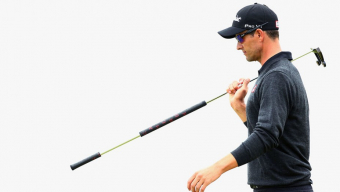Following the final round of The RSM Classic, David Hearn posted a photo of his Odyssey White Hot XG #7 long putter on Twitter with the caption, “Goodbye old friend.”
For Hearn and a few others in the field at Sea Island Resort’s Seaside Course, the tournament marked the end of an era for one of the most talked-about pieces of equipment in professional golf.
The anchored putter.
Ever since the USGA and R&A proposed changes to Rule 14-1 of the Rules of Golf in the spring of 2013, the clock has been ticking for players who “anchor” the putter against their stomach, chest or chin to come up with an alternative method.
The anchored putting method had been used for nearly 80 years and had seen a bump in usage on Tour in the last decade. But it wasn’t until Keegan Bradley won the 2011 PGA Championship with a 46.5-inch Odyssey White Hot XG Sabertooth that the putter suddenly found itself under a microscope.
Following Bradley’s win, the anchor chatter continued to build over the next two years, as Webb Simpson (2012 U.S. Open), Ernie Els (2012 Open Championship) and Adam Scott (2013 Masters) went on to win major championships with the belly and long putter.
After the conclusion of the 2013 season, the USGA and R&A announced the addition of Rule 14-1b to the Rules of Golf: a rule that prohibits anchoring the club when making a stroke.
“Our best judgment is that Rule 14-1b is necessary to preserve one of the important traditions and challenges of the game — that the player freely swing the entire club,” said then-USGA president Glen D. Nager. “The new rule upholds the essential nature of the traditional method of stroke and eliminates the possible advantage that anchoring provides, ensuring that players of all skill levels face the same challenge inherent in the game of golf.”
When the Jan. 1, 2016 deadline was officially put in place, players knew they had a three-year window to find an alternative. Some chose to treat the impending anchor ban like a Band-Aid, ripping it off as quickly as possible. Others, like Hearn, opted to use the putter until right before the deadline.
“Fortunately for me I putted on Tour when I first got on in [2005] with a short putter,” Hearn said at The RSM Classic. “It’s something I have done at a high level. I obviously prefer to putt the way I am right now, but I’m confident in my transition.”
Last week’s Sony Open at Waialae Country Club in Hawaii marked the first full-field Tour event without the anchored putter.
“It’s a change from one way of putting to something else, and that takes time,” Hearn said. “You just have to trust what you’re doing and feel comfortable with it when you’re on the course in competition. I guess only time will tell.”
Time will certainly tell if previous anchor users can find success with a non-anchored model. But if the last few years have taught us anything, it’s that there’s no such thing as a blueprint for a successful transition.
Webb Simpson, who used a PING G5i Craz-E belly putter, was one of the first to make a permanent switch at the end of the 2014 season when he put a conventional-length Odyssey White Hot Pro V-Line in play in Japan at the Dunlop Phoenix Open.
Wanting to avoid the temptation of going back to his belly putter, Simpson snapped the club over his knee and put it in his trophy case alongside the U.S. Open trophy that it helped win.
“I kept thinking in my head, just go one more year with the belly putter, you’ve had a great last four years,” Simpson said. “So I felt myself kind of backing out, and I tried to justify it with, you know, all these things. In front of my wife, I snapped it over my knee.”
While Simpson went the permanent route, others decided to leave the door ajar, in the event things didn’t go according to plan. One of those players was Keegan Bradley, who replaced his trusty belly putter with a non-anchored version (41 inches) at the 2014 Memorial.
The 2011 PGA Championship winner returned to his belly putter briefly before switching back to a shorter, conventional-length putter at the Travelers Championship last year.
“Ever since I’ve switched to this recent putter that I have, it’s a little lighter, it’s shorter, I feel as though I’ve putted as well or better than I did before,” Bradley said. “I had a putter early in the year that was longer and heavier that I wasn’t quite as consistent with. So it’s really nice to get on the greens and feel like I can make every putt I look at.”
Another high-profile late convert was 2013 Masters champion Adam Scott. The Aussie opened 2015 with a conventional-length Odyssey White Ice Core #7 putter at the World Golf Championships-Cadillac Championship.
But instead of giving the putter a lengthy test run, Scott went back to his Scotty Cameron Futura X Long in the run-up to the Masters. Wanting to give the long putter one last shot to win a major, Scott used the model for the rest of the season before moving into a 35-inch Scotty Cameron Rev X10 prototype — the putter had a similar head shape to the X6 putter Scott used at the 2015 U.S. Open — at the Presidents Cup last October.
“As far as putting goes, I’m putting very well,” Scott said of the new putter. “I putted poorly this year with the long putter, which made everything quite frustrating when you do putt poorly for a long period of time, like the whole year, makes the game very difficult. So I’ve putted nicely since putting with the short putter and that’s, I think, having a positive effect on the rest of my game as well.”





















